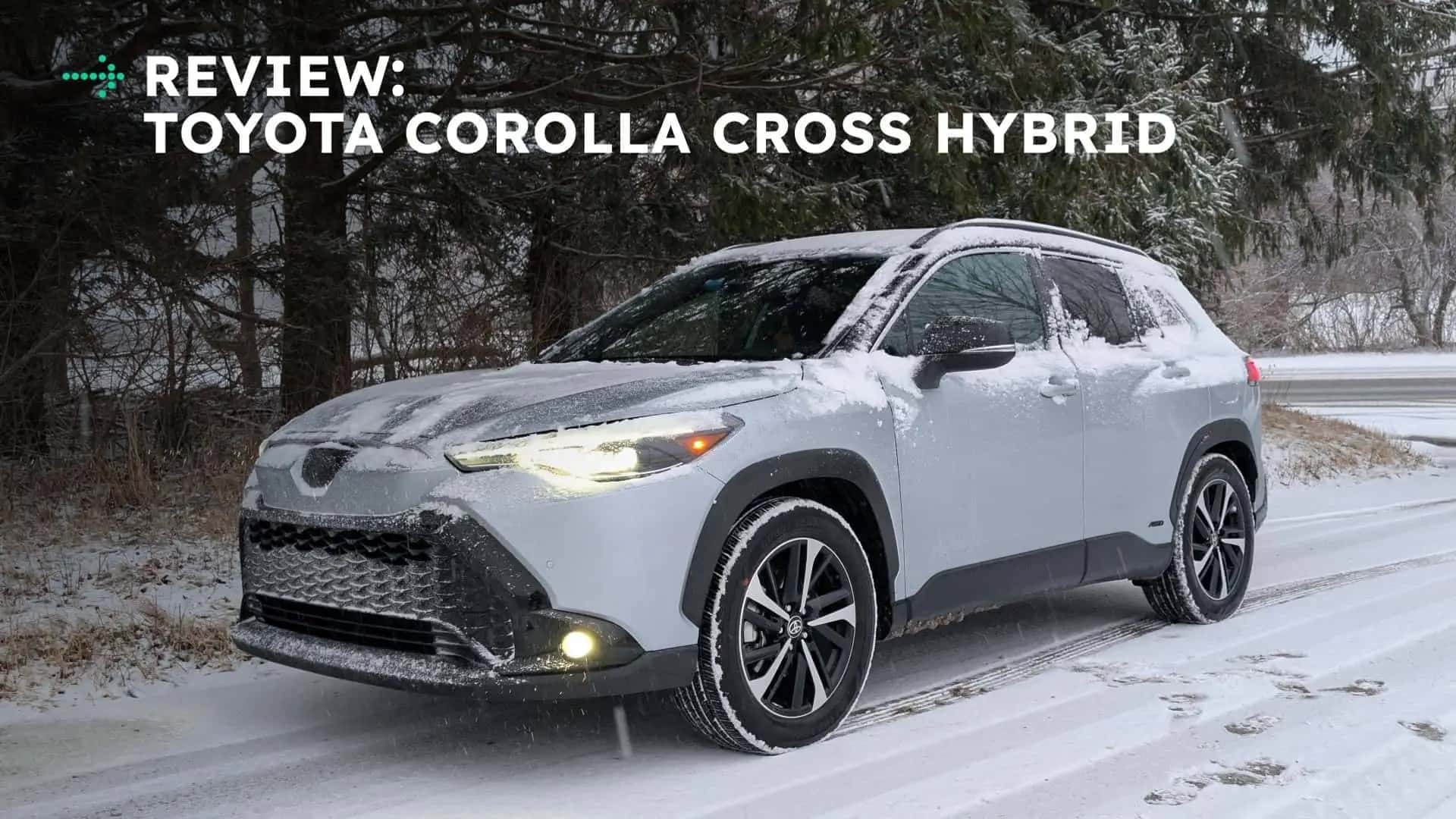
The elevated Corolla boasts an impressive hybrid system, yet transitioning to a fully electric setup would address numerous issues it faces.
Amid a flood of software-defined cars The Toyota Corolla Cross Hybrid, brimming with screens and automation, seems basic.
When I sat in it for the first time, the slim seats made me feel cramped. Gripping the unheated steering wheel at such a chilly -9°C (16°F) caused a cold shock throughout my frame. To unfold the manual side mirrors, I had to lower the window and extend my arm outside.
Nevertheless, once the hybrid system activated, it began in full electric vehicle (EV) mode, quiet and devoid of vibrations. At low speeds within urban areas and during deceleration on highways, the car relied solely on battery power. As velocity increased, the engine smoothly engaged without interruption. This approach, characterized by thriftiness, simplicity, and efficiency, appeals to numerous American consumers. Toyota In 2024, they sold 35,289 units of the Corolla Cross Hybrid, marking a significant increase of 128% compared to the previous year.
While it may not be the top seller—this title remains with the larger and more spacious RAV4 Hybrid, which attracted over 200,000 purchasers last year—the electric version of the Corolla SUV plays an essential role in Toyota’s "multi-pathway" approach. This strategy encompasses various powertrain options including internal combustion engine (ICE) vehicles, hybrid models, plug-in hybrids, fuel-cell cars, and fully electric vehicles as they all coexist within their lineup. selling more than a million electric cars In the United States last year—with most of these being hybrids—Toyota’s strategy has shown effectiveness, despite the associated costs. sluggish transition to EVs .
Should the Corolla Cross Hybrid catch your attention as you look for a new car? After testing it under different circumstances—a night-time drive during a harsh snowstorm—I concluded that its hybrid engine serves as both an advantage and a drawback. The issues with this model could potentially be addressed once Toyota eventually commits to making the entire Corolla range electric, which they have been delaying far too long.
( Full Disclosure: Toyota lent me a Corolla Cross Hybrid for a week in New York City. It was provided with a completely filled fuel tank, and I returned it with the same.
Design And Dimensions
The design of the Corolla Cross Hybrid has stayed the same since its introduction. started distributing to dealers in 2023 It has only undergone slight annual updates since then, such as the darker trim. Nightshade Edition It shares minimal similarities with its sedan counterpart, and there doesn’t appear to be a unified design theme between them.
At first glance, a massive grill takes center stage, accompanied by thick, curved LED headlights that appear unusually large for such a compact SUV. The sides gain some toughness with black trim, yet this toughened appearance fades away at the back, making it rather unremarkable. As a result, it merges seamlessly into the sea of generic crossover vehicles on the roads, offering little that would turn heads.
The sole touches of personality come from the 18-inch blackout alloy wheels and two-toned paint job, as the rest of the styling fails to make much of an impression.
The dimensions of this vehicle are 176.1 inches in length, 71.9 inches in width, and 64.9 inches in height, with an 8.0-inch ground clearance. In comparison, the RAV4 Hybrid is larger, spanning 180.9 inches in length, 73.3 inches in width, and standing at 67 inches in height, boasting a ground clearance of up to 8.6 inches. Having taken numerous Uber and Lyft trips in the RAV4 Hybrid—a common sight in New York City—I can confidently state that it offers more space and comfort.
Cabin And The Tech
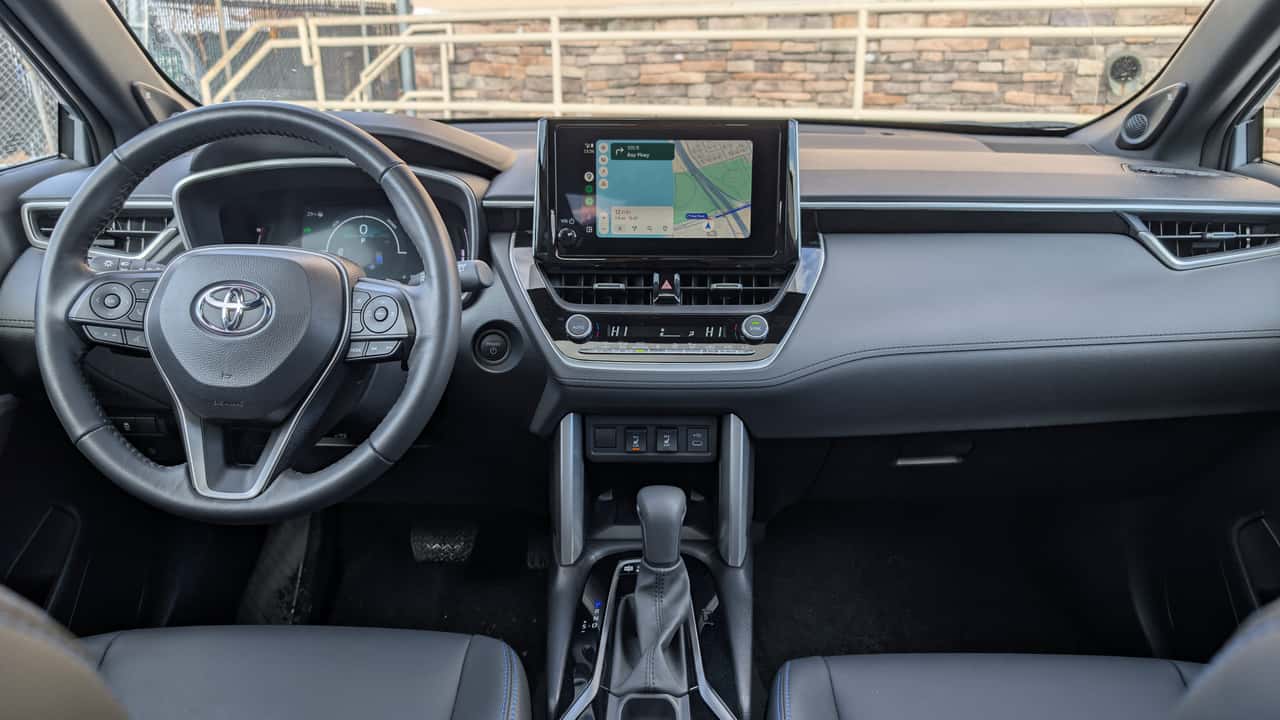
At the back, where I sat after adjusting the driver’s seat to fit my height of 5'7", there was sufficient knee space. However, this model isn’t known for spaciousness; tall riders might find more comfort in the RAV4. The interior feels tight up front as well, featuring small door compartments and a rather slim seat cushion. Sharing the central armrest is impractical since it lacks adequate width for both occupants’ elbows. While four individuals of standard build could handle brief rides without much issue, they'd require stops during extended travels to relieve their stiffness from being confined.
Here lies one of the clear benefits of electric vehicles concerning passenger space. In the case of the Corolla Cross Hybrid, its interior must accommodate both the conventional engine at the front and the hybrid battery located beneath the back seats. This positioning affects trunk volume as well, elevating the load area’s base level. By eliminating components such as the internal combustion engine, drive shafts, and standard gearboxes, manufacturers can design more spacious interiors with greater ease. Additionally, they integrate the high-voltage battery within the vehicle floor for better use of available space.
In terms of technology, the Corolla Cross Hybrid has an old-school charm that isn't inherently bad. It boasts a generous amount of actual buttons and dials, which means you can keep your focus on the road without needing to look away too much. Both the gearshift lever and climate controls are highlighted with chrome accents and offer a pleasant touch response. Additionally, the steering wheel's audio control and phone answer buttons are simple plastic elements—plain yet intuitive and straightforward to remember.
Although I generally prefer smaller displays, those in the Corolla Cross seem inadequate. Driving through New York City’s complex network of bridges and roads meant I had to spend more time focusing on the central 8.0-inch screen than I preferred, trying to decipher the minuscule icons and Google Maps arrows. It felt safer to depend on auditory cues to prevent missed exits. Additionally, the 4.2-inch instrument panel doesn’t show navigational data, which can be quite annoying.
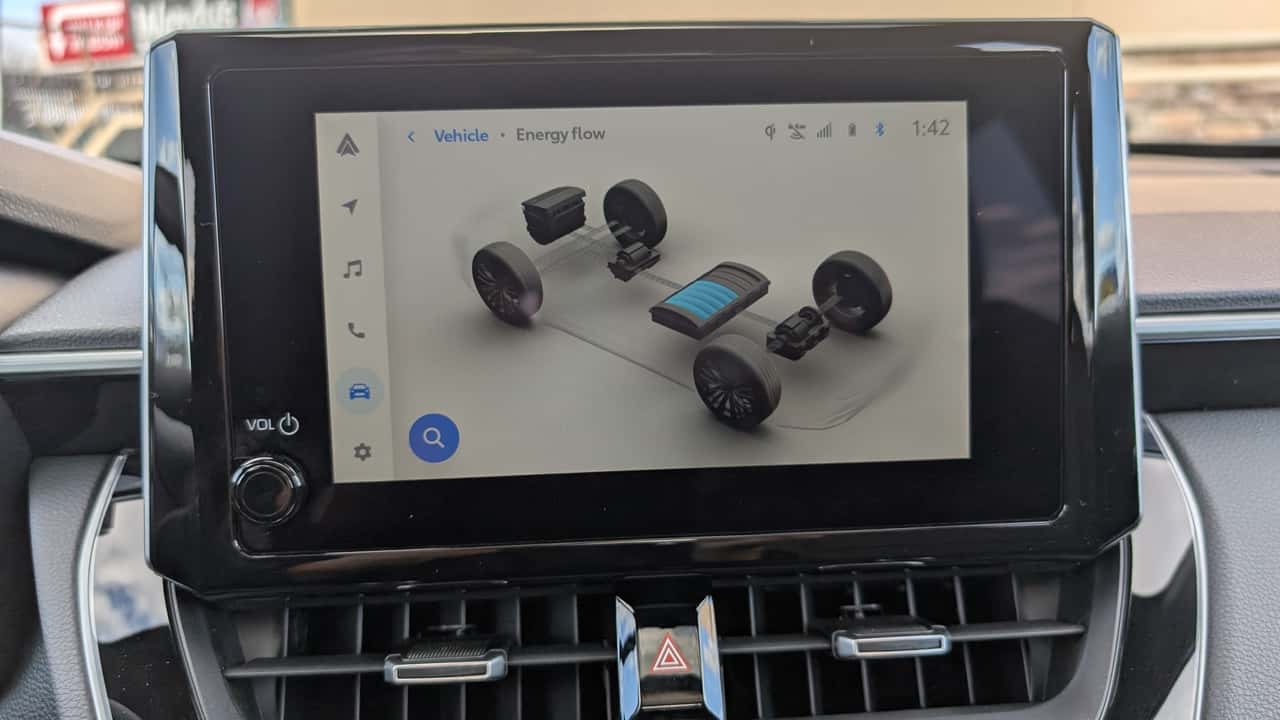
However, the main display – despite its small size – remains responsive. Throughout my seven-day trial period, I did not encounter any delays or issues with frames dropping. Both wireless Android Auto and Apple CarPlay are supported. Each time I got into the car, the latter paired seamlessly without any problems.
The displays excel at providing information about the drivetrain, efficiency, and energy usage. Similar to my appreciation for the "Energy Monitor" found in Toyota and Lexus hybrid vehicles, these screens offer clear, real-time graphics illustrating the electric drive contribution, the power source for the wheels, and regenerative braking effects. The interface is user-friendly; the use of green coloring ensures ease of reading, making it simple to monitor the car's instantaneous fuel efficiency effortlessly.
The Brilliant Hybrid Powertrain

When discussing efficiency, the hybrid Corolla stands out. In contrast to its sleek design, the SUV version bears minimal resemblance to its sedan counterpart. The Corolla Cross Hybrid shares its architecture with the Prius. However, unlike thePrius which is exclusively front-wheel drive, theCorolla Cross Hybrid boasts an all-wheel-drive system.
The loud 2.0-liter, four-cylinder naturally-aspirated engine produces 169 horsepower along with 151 pound-feet of torque. A 4-kWh lithium-ion battery situated beneath the rear seat assists this setup; it drives three electric motors—two positioned up front and one located on the rear axle. Together, they deliver an aggregate power of 196 hp.
The initial electric motor (Motor/Generator 1 or MG1), situated behind the engine, quietly initiates the vehicle’s operation and smoothly turns the engine on or off as required. When the battery level drops, MG1 uses the engine's power to recharge the lithium-ion battery. Meanwhile, Motor Generator 2 (MG2), which is connected to the transmission (E-CVT), powers the front wheels either autonomously or alongside the gasoline engine. Additionally, MG2 functions as a generator during regenerative braking processes.
This vehicle typically operates as a front-wheel-drive but switches to an all-wheel-drive system during low-traction scenarios due to the inclusion of a third electric motor (Motor/Gear Unit Rear or MGU-R) at the rear axle. This particular all-wheel-drive arrangement is notably straightforward. In contrast to conventional all-wheel-drive cars that utilize a physical driveshaft for distributing power across all four wheels, the MGU-R lacks any direct mechanical linkage with the remaining components of the driveline. It activates solely when traction decreases. As a consequence of these advanced technological features developed over time, the car achieves impressive fuel economy.
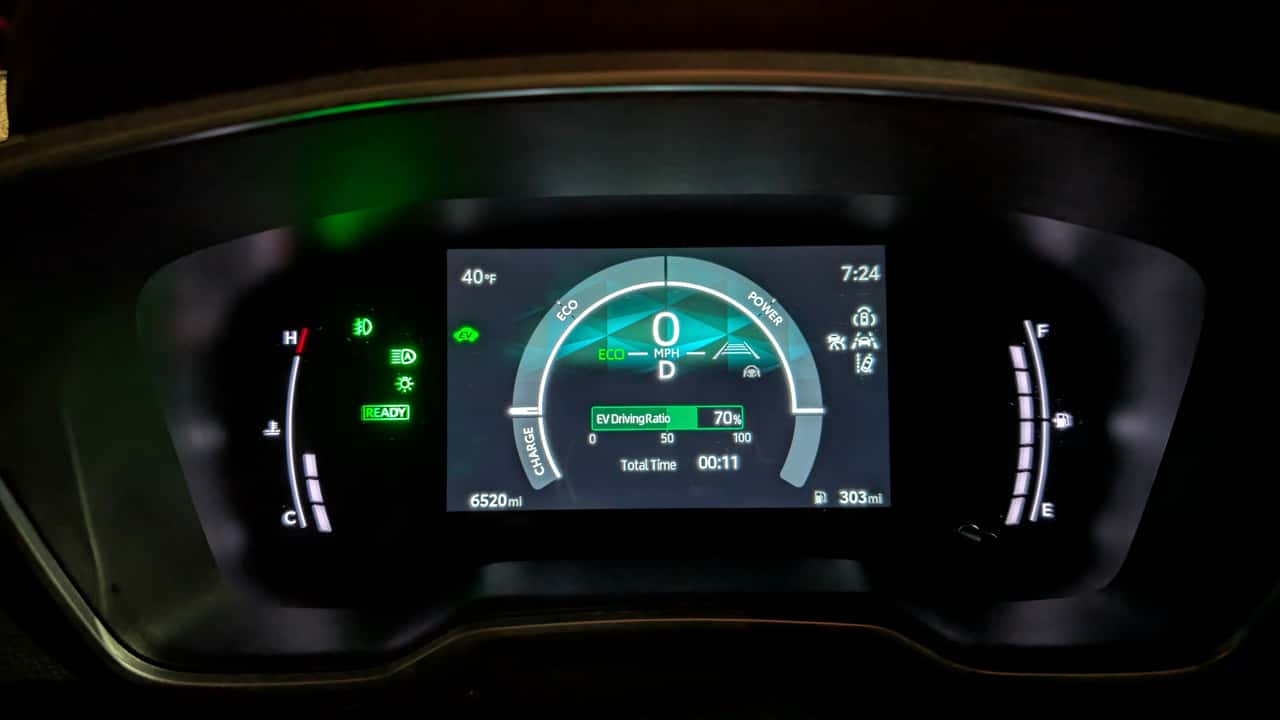
Over approximately 150 miles of varied driving—encompassing both urban and motorway routes under cold weather conditions—the observed fuel efficiency came out to be around 37 miles per gallon. During an individual assessment within just the city area, using distinct fuel-saving measures, my mileage improved to 42 mpg, with data from the onboard system indicating that electric-only propulsion accounted for about 70% of this journey. Nonetheless, during the combined condition evaluation, I alternated among Normal, Eco, and Sport settings and adhered mostly to recommended speeds throughout most of the trip.
The Environmental Protection Agency reports that the Corolla Cross Hybrid can reduce fuel expenses by $3,250 over half a decade when contrasted with an average new vehicle. The model boasts an EPA-estimated mileage of 45 miles per gallon in urban areas, 38 miles per gallon on highways, and an overall combined rating of 42 miles per gallon.
The hybrid powertrain also enhances grip in low-traction conditions. Generally, all-wheel-drive automobiles consume more fuel compared to their front- or rear-wheel-drive counterparts because of the additional energy needed to rotate all four wheels. However, the Corolla Cross Hybrid bucks this tendency.
When I returned from a ski trip in Connecticut with some buddies, a heavy snowstorm hit the northeastern region. Visibility was terrible. I witnessed several rear-wheel-drive sedans losing control because they couldn’t get proper grip on the road. However, the Corolla Cross Hybrid seamlessly shifted between front-wheel drive and all-wheel drive as needed, providing additional power to the back wheels whenever required—all without affecting its fuel efficiency.
Most of the journey through the blizzard passed without incident as both companions were fast asleep, adding to the serene nature of the trip—especially considering we were mostly relying on front-wheel drive. Over approximately fifty miles during the height of the snowstorm, our fuel economy displayed around 36 mpg. However, keep in mind that the available E-AWD system isn’t intended as a substitute for proper winter tires or comprehensive four-wheel-drive setups found in rugged, off-road-oriented vehicles. This feature manages slight loss of traction but won't be conquering mountainous regions like the Rockies anytime soon.
Verdict
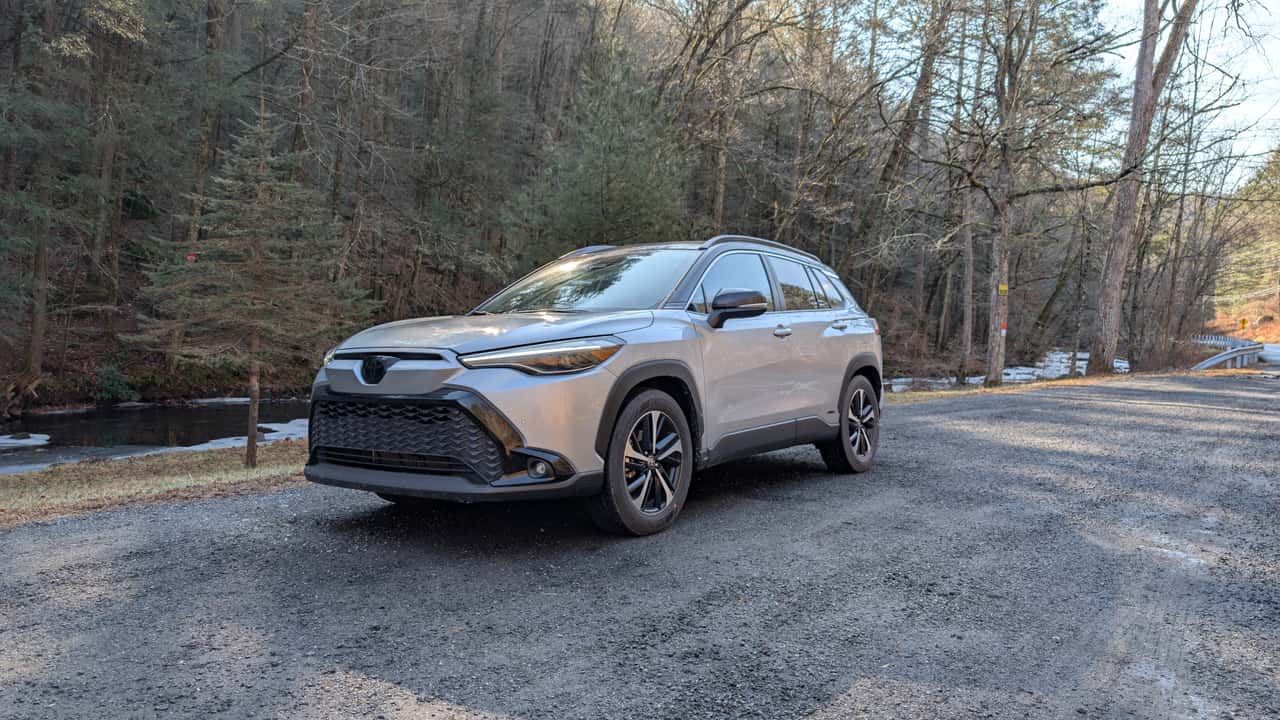
The Corolla Cross Hybrid has a starting price slightly above $28,000 excluding destination fees, making it quite attractive given the advanced nature of its hybrid system. However, during my test drive of the top-of-the-line XSE version, the total cost came to $34,320 including destination charges. This places it closer to the pricing range of the RAV4 Hybrid, which begins at $31,900. Given this, it becomes challenging to justify buying one unless you value its features despite being pricier than some roomier alternatives offering similar fuel economy. Additionally, achieving such an entry-level price could prove difficult were it a fully electric vehicle. various choices such as the Hyundai Kona Electric Do you feel like valued contenders here?
The hybrid setup serves both as an ally and adversary for the Corolla. Despite offering impressive fuel economy, it compromises interior room and lacks advanced features common in contemporary software-defined cars. Additionally, the powertrain does not position it as a champion in terms of driving distance. With a completely filled tank, the car showed a potential travel distance of only 350 miles. Although replenishing its tanks might be more convenient, the expanding network of chargers across America means that numerous electric vehicles now boast ranges exceeding 300 miles.
Certainly, the E-AWD enhances fuel efficiency and grip, yet it falls short compared to the advanced systems found in battery electric vehicles. During that blizzard, all-wheel drive Teslas they were easily surpassing me—the electric motors excel at smoothly modulating power delivery, enabling superior precision in traction control.
Integrating hybrid technology into the Corolla Cross enhances its appeal significantly. The impressive miles per gallon figures make it an attractive option for those aiming to reduce their fuel costs and lower emissions without being concerned about issues such as limited charging stations. This demonstrates the great potential of the practical and adaptable Corolla, which comes in various forms including wagons, sedans, crossovers, gasoline versions, and hybrids available globally. crazy hot hatchback forms —still has even today.
However, I am anticipating the moment when the Corolla becomes completely electrified as well. This option is absent from the so-called "multi-pathway" strategy, and should it occur, it might truly revolutionize the industry.
Got a tip? Reach out to the author: suvrat.kothari@insideevs.com
Related Stories
- Anti-Tesla Demonstrations Increase as Musk Draws from US Treasury
- Trump Aims at California's Ban on Gas-Powered Cars: How This Impacts the Rest of Us
- Here’s How Far This Tesla Model S Can Go After 250,000 Miles
- The Kia EV4 Has Arrived and It Matches the Concept Car Perfectly
| Toyota Corolla Cross Hybrid Features | |
| As-Tested Price | $35,670 |
| Base Price | $28,395 |
| Drive Type | Electronic on-demand all-wheel drive |
| Output | 196 horsepower (combined) |
| Efficiency | 37 mpg (Based on testing) |
| Engine | 2-liter 4-cylinder NA |
| Ground clearance | 8.0 inches |
| Height | 64.9 inches |
| Length | 176.1 inches |
| Width | 71.9 inches |
| Motor | Two front, one rear. |
| Battery | 4-kWh lithium-ion. |
| Transmission | E-CVT |
| Weight | 3,373 lbs (curb weight) |
